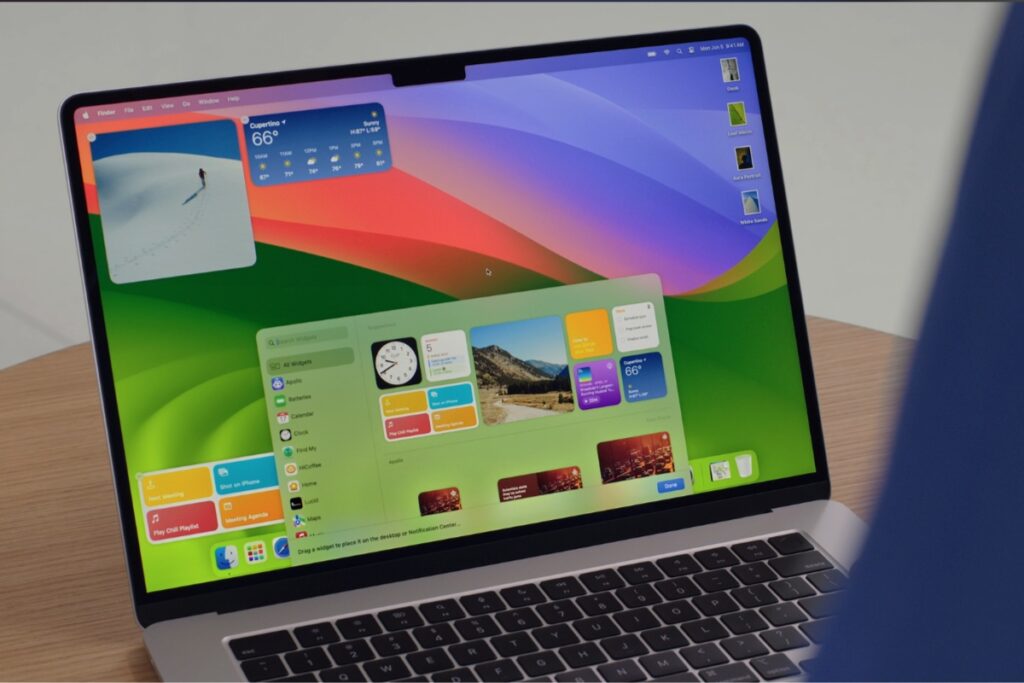macOS 14 Sonoma superguide: Everything you need to know

The newest version of macOS–Sonoma–named after the Californian wine region, is now available. Among the new features arriving on Macs with Sonoma (aka macOS 14) are changes to widgets, a new Game Mode, the ability to easily turn web pages into web apps, and fun additions to video conferencing apps. Read on for the lowdown on all the new features and further improvements coming later in 2023.
Update November 28: Apple has released the fourth beta of macOS Sonoma 14.2.
macOS 14 Sonoma: Latest version
The final version of macOS 14 was released to the general public on Tuesday, September 26 (which was the earliest macOS release date since 2018).
The initial release of Sonoma was on September 26, 2023. That was version macOS 14.0.
The latest version is macOS Sonoma 14.1.1, which arrived on November 7. It includes bug fixes and security updates and is recommended for all users.
Prior to that macOS Sonoma 14.1, was released on October 25.
There will be a lot of updates over the coming months, both minor point releases for bug fixes and security updates and major releases that add some of the Sonoma features that weren’t available at launch.
macOS 14 Sonoma beta: Latest version
Even though macOS Sonoma has arrived, Apple is continuing to test a developer version and a public version of the beta. This is how Apple will test new features that will come later in 2023 and throughout 2024.
The latest beta version is macOS 14.2 which was released to developers on October 26. The fourth update to the 14.2 beta came on November 28.
macOS 14.2 Sonoma release date and new features
macOS 13.2 arrived on January 23, 2023, which was about six weeks after 13.1 arrived. On that basis, we could expect macOS 14.2 around December 6, 2023.
New features in the beta are mainly technology-related and will be less apparent to general users. They include:
iMessage Contact Key Verification: Improved security for contact key verification users.
StoreKit: Price, currency, and currencyCode are now available on Transaction.
We know that the following features are coming to apps in iOS 17.2, so we can expect to see them in the equivalent apps on macOS:
News app: The News app will support Live Activities.
Apple Music: Collaborative playlists and Favorites playlists. You will also be able to disable the listening history in Apple Music so it doesn’t impact Apple Mucis suggestions.
TV app: There will no longer be separate Movies and TV Shows tabs. Just a Store tab.
Messages: You can react to iMessages with any emoji or sticker. Warning for stickers if you have enabled it for Messages.
How to install macOS 14 Sonoma
We cover how to install macOS Sonoma in a separate article, we also cover some of the issues you might encounter installing Sonoma, so if you do have any difficulties check out that article. It should be simple enough to install macOS Sonoma though.
Go to System Settings (System Preferences in older versions of macOS).
Click on General.
Click on Software Update and your Mac will search for the update. If it’s the day that Sonoma arrives, you may have to wait a while before it shows up.
Click on Upgrade Now and wait for the macOS installer to download.
Once the installer has downloaded click on Install and wait while the software is installed on your Mac (during which time you won’t be able to use the Mac.)
macOS 14 Sonoma: How to install and remove the beta
If you are a beta tester you may want to stop receiving beta updates once the full version of Sonoma arrives. In which case you can go to Software Updates, click on the (i) beside Beta updates and turn them off–that way you shouldn’t receive any more beta versions of the software and will be able to update to the full version of macOS 14. This process is a little more complicated if you want to downgrade from the iOS 17 beta to iOS 16, or from a subsequent beta of iOS 17 to the original version. If you then want to uninstall the beta, we have a guide for that: How to remove macOS Sonoma beta.
If you haven’t been part of the beta but want to join, installing the beta is simple, especially since Apple changed the beta process in macOS 13.4. It used to be necessary to download the Beta Access Utility for every device, but now you only need to register your Apple ID for the beta program to install betas on every Apple device that is signed into that account.
Then when you go to Software Update, you’ll see a new tab for Beta Updates, which will list the beta versions that are available to you. If you want to install the public beta, select macOS 14 Public Beta.
Just remember: betas are not as stable as the official version–features may be implemented and then withdrawn, or they may not work properly, UI can change, and third-party app compatibility isn’t guaranteed.
If you want to install the beta, follow our macOS beta installation guide. For more on joining the beta program read: How to join Apple’s beta program and try out new software.
macOS Sonoma compatibility: Which Macs will be able to run macOS 14?
Apple has dropped support for some 2017 Macs, according to the Sonoma compatibility list.
These are the Macs that are able to run macOS Sonoma.
iMac from 2019 and later
Mac Pro from 2019 and later
iMac Pro from 2017
Mac Studio from 2022 and later
MacBook Air from 2018 and later
Mac mini from 2018 and later
MacBook Pro from 2018 and later
When Apple released macOS Ventura, the following Macs could run it:
MacBook models from 2017 or later
MacBook Air models from 2018 or later
MacBook Pro models from 2017 or later
Mac mini models from 2018 or later
iMac models from 2017 or later
iMac Pro (all models)
Mac Pro models from 2019 or later
Mac Studio (all models)
There is always the possibility that a Mac may be compatible with macOS 14, but some of the new features won’t run on older Macs on the list. Some new features may also require Apple chips and not run on Intel-based Macs.
To find out which version of macOS older Macs can run take a look at our macOS compatibility list.
macOS 14.1 features
The macOS 14.1 update included a new Coverage section in the General System Settings that includes Apple Care information. It also provides a fix for an issue with Remote Widgets and addresses issues with Wallet and WidgetKit.
This update arrived on 25 October, which means it will have taken fewer weeks than the initial .1 update for macOS Ventura (Ventura arrived on October 24 and macOS 13.1 arrived seven weeks later, on December 13).
macOS 14 Sonoma features
Here are the new features have been promised for macOS Sonoma. Some arrived with the first release and others will come later. R
Read our comparison of macOS Sonoma and macOS Ventura for more details about what’s changed and find out which Sonoma features are coming later to find out what which ones will arrive later.
Apple
Login Screen changes
From the moment that your Mac starts up in Sonoma you will notice the difference. Apple has redesigned the login screen so that you enter your password at the bottom rather than the middle of the screen.
We explain how to navigate the new Lock Screen and set your preferences here: How to customize and navigate the new login screen.
Desktop widgets
You’ll be able to add more Widgets from the Widget Gallery and place them anywhere on the screen. Apple has gone to lengths to make sure they aren’t distracting, they will essentially fade into the background.
You will also be able to add Widgets from an iPhone using Continuity, the iPhone just needs to be nearby, on or same Wi-Fi network. Read: How Apple’s upcoming widget revolution will change our screens forever.
Learn how to add widgets to the macOS Sonoma Desktop.
Apple Music
Speaking of Widgets, there will be a new Apple Music widget, but it won’t be available at launch.
There are other features coming to Music including Playlist collaboration, Favorite Songs playlist, and Favorites in Library, but again all of these will arrive later.
Coming later in 2023.
Login screen
Apple has made some changes to the login screen, and added a new immersive animation that leads into your desktop.
Wallpapers
Apple is adding some beautiful animated wallpapers showing locations from around the world. See: The best wallpapers included in macOS Sonoma.
Personal Voice
A new Personal Voice feature will allow you to train your Mac to talk with your voice and then use that to convert text to speech. We explain how to use it here: macOS Sonoma: How to train your Mac to talk in your voice
Game Mode
This new mode will ensure the game gets the highest priority on GPU and CPU, which should help with playability. It will, Apple says, make gaming on Mac “more immersive.” There are also changes that should reduce latency with controllers and improve in-game responsiveness. These sound like improvements that could help improve gaming on the Mac, but it may just be too little too late.
Apple announced that there are more Mac games coming, and demonstrated “Death Stranding: Directors Cut” (which is unfortunately not a new game). Apple also explained how it will help game developers bring their games to the Mac with a new Game Porting kit that includes tools that devs can use to quickly port their games to the Mac, significantly reducing the game development time. Read: Apple’s Game Porting Toolkit is the first real step to fixing Mac gaming. We also explain How to use Game Mode to boost performance.
Video conferencing
Apple
Apple described how when you share your screen during a presentation your presence can get lost. To fix this issue Apple has devised a new video effect called Presenter Overlay which will overlay your face over the presentation, separating you from the background. This can appear like the picture above, or be a smaller bubble with your face in (which may cover less of the presentation).
Other new features include the ability to add a reaction to your video to show how you feel about something. For example, if you show two thumbs up a fireworks animation will play. These features can also be used as video effects with other video conferencing apps, so it’s not tied to FaceTime.
Safari
More updates are coming to WebKit, including new typography. Private browsing will get a new feature that will block private browsing windows when you aren’t using them. It will be possible to share Passkeys and Passwords with family members, This will be end-to-end encrypted via iCloud Keychain. You will be able to create Safari Profiles so you can separate accounts between work and home/school profiles.
See: Safari 17: All the new features coming to your Mac this fall
Web apps
It will be easy to make a website you use a lot into a Web App. Just open the webpage and choose File > Add to Dock to add a webpage to the Dock as an icon and open it to get an app-like appearance for that web page that opens outside of Safari. Learn how to make and manage Web Apps in macOS Sonoma.
PDFs and Notes
AutoFill will make it easy to fill out PDFs faster and securely. You will also be able to view PDFs in Notes, link related notes, and open a Note in Pages to update it there.
The AutoFill for PDFs is a feature coming later in 2023.
Apple
Keyboard
Changes to the keyboard will include improved Autocorrect and typing predictions. But this is a feature coming later.
Coming later in 2023.
Messages
You can expect improved Search of the Messages app, being able to refine your search as you go.
There will also be warnings about potentially sensitive videos and photos before you open them.
A new Sticker drawer, catchup for group conversations and improvements to Messages in iCloud will also come later.
Some features coming later in 2023.
Security
Improvements to Lockdown Mode will help protect against cyber attacks.
MacOS

